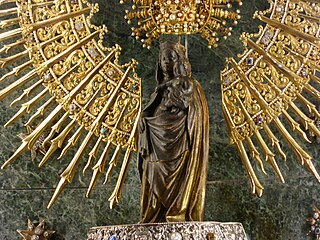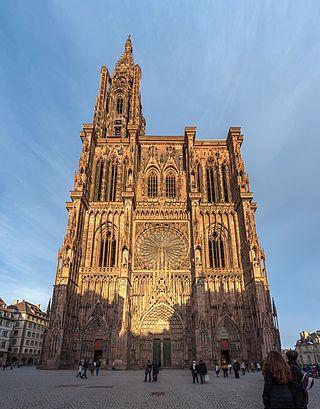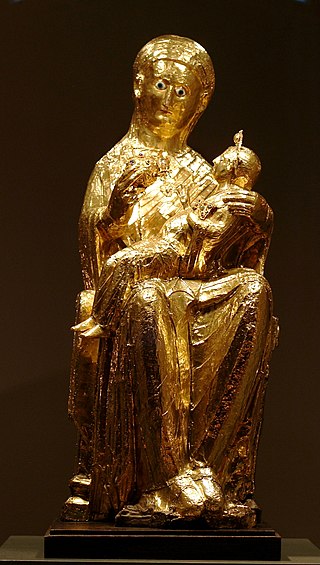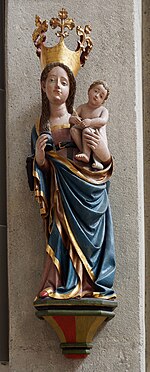
Hildesheim is a city in Lower Saxony, Germany with 101,693 inhabitants. It is in the district of Hildesheim, about 30 km (19 mi) southeast of Hanover on the banks of the Innerste River, a small tributary of the Leine River.

Our Lady of the Pillar is the name given to the Blessed Virgin Mary in the context of the traditional belief that Mary, while living in Jerusalem, supernaturally appeared to the Apostle James the Greater in AD 40 while he was preaching in what is now Spain. Those who adhere to this belief consider this appearance to be the only recorded instance of Mary exhibiting the mystical phenomenon of bilocation. Among Catholics, it is also considered the first Marian apparition, and unique because it happened while Mary was still living on Earth.

Strasbourg Cathedral or the Cathedral of Our Lady of Strasbourg, also known as Strasbourg Minster, is a Catholic cathedral in Strasbourg, Alsace, France. Although considerable parts of it are still in Romanesque architecture, it is widely considered to be among the finest examples of Rayonnant Gothic architecture. Architect Erwin von Steinbach is credited for major contributions from 1277 to his death in 1318, and beyond through his son Johannes von Steinbach, and his grandson Gerlach von Steinbach, who succeeded him as chief architects. The Steinbachs's plans for the completion of the cathedral were not followed through by the chief architects who took over after them, and instead of the originally envisioned two spires, a single, octagonal tower with an elongated, octagonal crowning was built on the northern side of the west facade by master Ulrich von Ensingen and his successor, Johannes Hültz. The construction of the cathedral, which had started in the year 1015 and had been relaunched in 1190, was finished in 1439.

The Virgin of Paris or Notre-Dame de Paris is a near life-size stone statue, 1.8 metres tall, of the Virgin and Child created in the early 14th century. The statue was commissioned for, and remains in the Cathedral of Notre-Dame in Paris, where it survived the 2019 Notre-Dame fire. It is an example of the court style in Late Gothic sculpture.

Hildesheim Cathedral, officially the Cathedral of the Assumption of Mary or simply St. Mary's Cathedral, is a medieval Roman Catholic cathedral in the city centre of Hildesheim in Lower Saxony, Germany, that serves as the seat of the Diocese of Hildesheim. The cathedral has been on the UNESCO World Cultural Heritage list since 1985, together with the nearby St. Michael's Church because of its unique art and outstanding Romanesque architecture.

Regensburg Cathedral, also known as St. Peter's Cathedral, is an example of important Gothic architecture within the German state of Bavaria. It is a landmark for the city of Regensburg, Germany, and the seat of the Catholic Diocese of Regensburg.

Bernward was the thirteenth Bishop of Hildesheim from 993 until his death in 1022.

Bremen Cathedral, dedicated to St. Peter, is a church situated in the market square in the center of Bremen. The cathedral belongs to the Bremian Evangelical Church, a member of the umbrella organization Protestant Church in Germany. It is the previous cathedral of the former Prince-Archbishopric of Bremen. Since 1973, it is protected by the monument protection act.

The Golden Madonna of Essen is a sculpture of the Virgin Mary and the infant Jesus. It is a wooden core covered with sheets of thin gold leaf. The piece is part of the treasury of Essen Cathedral, formerly the church of Essen Abbey, in North Rhine-Westphalia, Germany, and is kept on display at the cathedral.

The Church of Our Lady is a Roman Catholic church in Bruges, Belgium, dating mainly from the 13th, 14th and 15th centuries. Its 115.6-metre-high (379 ft) tower remains the tallest structure in the city and the third tallest brickwork tower in the world.

Essen Minster, since 1958 also Essen Cathedral is the seat of the Roman Catholic Bishop of Essen, the "Diocese of the Ruhr", founded in 1958. The church, dedicated to Saints Cosmas and Damian and the Blessed Virgin Mary, stands on the Burgplatz in the centre of the city of Essen, Germany.

The Virgin and Child with Saint Anne or Madonna and Child with Saint Anne is a subject in Christian art showing Saint Anne with her daughter, the Virgin Mary, and her grandson Jesus. This depiction has been popular in Germany and neighboring countries since the 14th century.

Münster Cathedral or St.-Paulus-Dom is the cathedral church of the Catholic Diocese of Münster in Germany, and is dedicated to Saint Paul. It is counted among the most significant church buildings in Münster and, along with the City Hall, is one of the symbols of the city.

St. Mary's Church in the town of Mühlhausen, central Germany, is the second-largest church building in Thuringia after Erfurt Cathedral. It was constructed mainly during the 14th century in the Gothic style. The church's 86.7-metre-high central spire, built in 1898 to 1903, is the highest in the state and forms a significant feature of the town's skyline. St. Mary's was a site of events relating to the German Peasants' War around 1525, as the revolutionary leader Thomas Müntzer was active as a pastor at the church. The Sauer organ, built in 1891, is considered the largest surviving 19th-century organ in Thuringia.

The Bronze baptismal font in the Hildesheim Cathedral is a late Romanesque baptismal font which was probably made in Hildesheim in the first third of the thirteenth century. It is noted for its pictorial decoration which is of the highest quality and for its perfect proportions and is considered among the most outstanding works of its type. For centuries the baptismal font stood in the western part of the nave, until it was moved to the last of the northern side-chapels in 1653. During the ongoing renovations of the cathedral (2010–2014) it is being displayed in the Bode Museum in Berlin. After the completion of the renovation work, it will be placed in the centre of the nave under the Hezilo chandelier.

The Strakonice Madonna is a Gothic wooden sculpture of the Madonna and Child of about 1300-1330. It comes from the Johannite Commandry in Strakonice that was founded in 1243. It is a rare surviving early Gothic sculpture that is directly related to French or Rhineland cathedral sculpture of the 13th century. It is exhibited in the permanent collection of medieval art at the National Gallery in Prague.

The Beautiful Madonna from Toruń - a Gothic sculpture depicting Mary and Infant Jesus. One of the most valuable, in terms of artistic value, images of the Madonna and Child made at the turn of the 14th and 15th century. In terms of typology and stylistics, this work is pars pro toto of the Beautiful Madonna, an iconographic type shaped before 1400. The sculpted images of Beautiful Madonnas represent the Beautiful style, a stylistic trend shaped during the Gothic period in Central Europe.

The Sternberg Madonna is a sculpture from the 14th century. It is one of the most important Bohemian Madonnas in the Beautiful Style and is protected as a Czech national cultural monument. It was discovered in 1957 in the filial church in Babice, which was part of the property of the Sternberg family. It is one of a group of "Beautiful Madonnas" created by artists from the circle of the Master of the Toruń Madonna. It is displayed in the permanent exhibition of medieval sculpture in the Olomouc Archdiocesan Museum.

The Velhartice Ark, dating from 1490 to 1500, is almost the only completely preserved late Gothic altar of its kind in the Czech lands. The altar is exceptional in the quality of its carving. It was originally commissioned for the parish church of the Nativity of the Virgin Mary in Velhartice in south-west Bohemia, where it probably stood on the mensa of the main altar. It is on display in the exposition of medieval art of the National Gallery in Prague.

The Madonna of Rudolfov is one of the most valuable monuments of early Gothic sculpture in Bohemia. It probably dates back to the end of the reign of Ottokar II of Bohemia, when the Dominican Church of the Presentation of the Blessed Virgin Mary in České Budějovice was consecrated in 1274. It is on display in the permanent exhibition of the Aleš South Bohemian Gallery in Hluboká nad Vltavou.




















